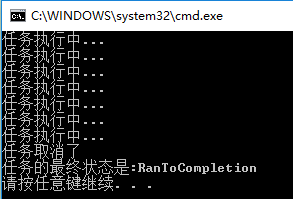C#多线程异常处理转载(二)
常规Thread中处理异常
使用Thread创建的子线程,需要在委托中捕捉,无法在上下文线程中捕捉
static void Main(string[] args)
{
ThreadStart threadStart = DoWork;
Thread thread = new Thread(threadStart);
thread.Start();
thread.Join();
}
static void DoWork()
{
try
{
throw new Exception("子线程出现异常了");
}
catch (Exception ex)
{
Trace.Assert(false, "Catch In Delegate");
}
}
Task中处理异常
1.仍然可以在委托中捕获异常
2.可以捕获Task.Wait() 或者 Task.Result 的 AggregateException 异常
try
{
task.Wait();
}
catch (AggregateException ex)
{
Console.WriteLine($"Error: {ex.GetType().Name}");
foreach (Exception item in ex.InnerExceptions)
{
Console.WriteLine($"{item.GetType().Name}, {item.Message}");
}
}
AggregateException 是并行任务中捕获的一组异常
通过延续任务捕获前驱任务中的异常
static void Main(string[] args)
{
Task task = Task.Run(() => throw new Exception("前驱任务异常了"));
Task faultedTask = task.ContinueWith(antecedentTask =>
{
antecedentTask.Exception.Handle(eachE =>
{
Console.WriteLine($"Error: {eachE.Message}");
return true;
});
},TaskContinuationOptions.OnlyOnFaulted);
faultedTask.Wait();
}
前驱任务:使用Run书写的第一个任务就是前驱任务
延续任务:在一个任务后使用ContinueWith添加的任务就是延续任务,延续一般是一个全新的工作线程
TaskContinuationOptions:指定延续任务时的可配置项,默认情况下前驱任务完成后,立即执行延续任务,OnlyOnFaulted表示只有前驱任务失败(出异常的时候)才会执行这一个延续任务
Task.Exception也是一个AggregateException 异常
注意:
1.当指定的TaskContinuationOptions与前驱任务运行结果不一致时,强制调用延续任务Wait()会引发TaskCanceledException异常
static void Main(string[] args)
{
Task task = new Task(() =>
{
Console.WriteLine("前驱动任务执行中...");
});
Task faultedTask = task.ContinueWith(antecedentTask =>
{
Console.WriteLine("延续动任务执行中...");
}, TaskContinuationOptions.OnlyOnFaulted);
task.Start();
try
{
faultedTask.Wait();
}
catch (AggregateException ex)
{
Console.WriteLine($"Error: {ex.GetType().Name}");
foreach (Exception item in ex.InnerExceptions)
{
Console.WriteLine($"{item.GetType().Name}, {item.Message}");
}
}
Console.WriteLine($"前驱任务状态{task.Status}");
Console.WriteLine($"延续任务状态{faultedTask.Status}");
}
Ctrl+F5 输出

补充:
假如在前驱任务中出现了异常,如OnlyOnFaulted所愿,会执行faultedTask任务,并且在faultedTask.Wait()中不会捕捉到前驱任务的异常,具体看下面一点
2.延续任务虽然在异步任务中提供了类似if else 的ContinueWith但是在异常处理上还是有点局限,看一个例子
static void Main(string[] args)
{
Task task = Task.Run(()
=>
throw new Exception("前驱任务异常了"));
Task task1 = task.ContinueWith(antecedentTask =>
{
throw new Exception("延续任务1异常了");
});
Task task2 = task1.ContinueWith(antecedentTask =>
{
throw new Exception("延续任务2异常了");
});
Task task3 = task2.ContinueWith(antecedentTask =>
{
throw new Exception("延续任务3异常了");
});
try
{
task3.Wait();
}
catch (AggregateException ex)
{
Console.WriteLine($"Error: {ex.GetType().Name}");
foreach (Exception item in ex.InnerExceptions)
{
Console.WriteLine($"{item.GetType().Name}, {item.Message}");
}
}
}
Ctrl+F5 输出

其实这样也可以理解,task3.Wait()只会收集task3所在工作线程上的异常,遗憾的是Task.Exception.InnerExceptions是一个只读集合,这样一来,每个任务的异常只能在各自委托中处理了,事实上也应该如此,可以使用TaskContinuationOptions进行灵活控制
使用CancellationTokenSource取消任务
static void Main(string[] args)
{
CancellationTokenSource cancellationTokenSource = new CancellationTokenSource();
cancellationTokenSource.Token.Register(() =>
{
Console.WriteLine("任务取消了");
});
cancellationTokenSource.CancelAfter(2000);
Task task = Task.Run(() =>
{
while (true && !cancellationTokenSource.IsCancellationRequested)
{
Console.WriteLine("任务执行中...");
Thread.Sleep(300);
}
},
cancellationTokenSource.Token);
task.Wait();
Console.WriteLine($"任务的最终状态是:{task.Status}");
}
Ctrl+F5 输出

正常取消的任务最终状态是 RanToCompletion ,这里要注意的是,CancelAfter()是在这个方法调用的那一刻开始计时的(并非以Run开始计时,好吧,很好理解,我却疑惑了半天)
小结:
结合 TaskContinuationOptions 和 CancellationTokenSource 可以很好处理多任务中异常,但是编写在异步程序还是很繁琐的,具体的在下一个笔记中会结合C#5.0做一个比较


